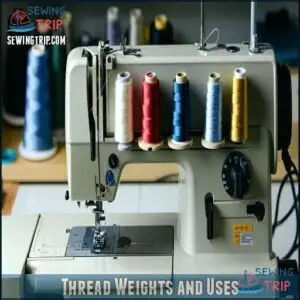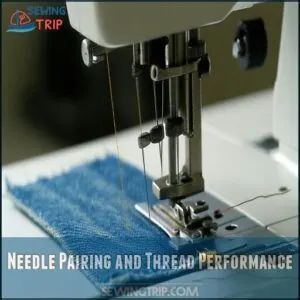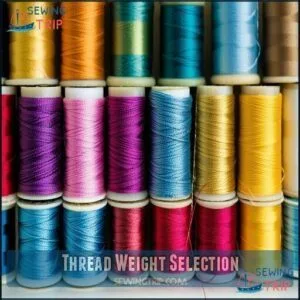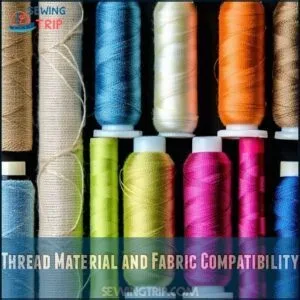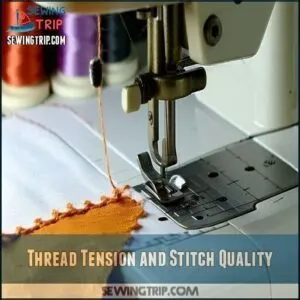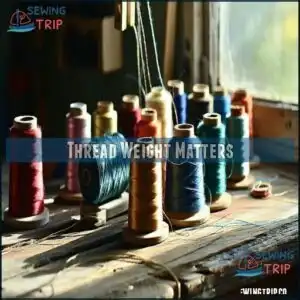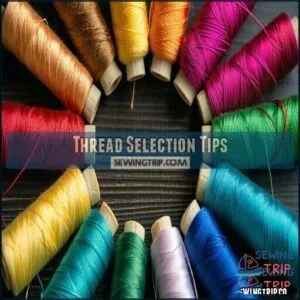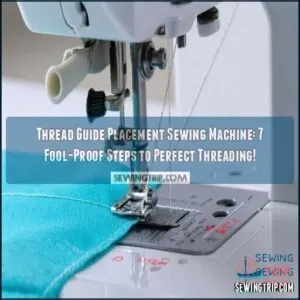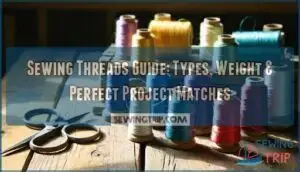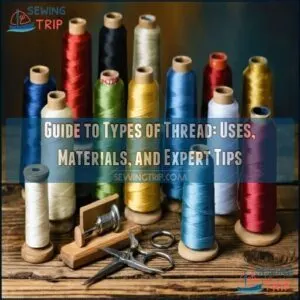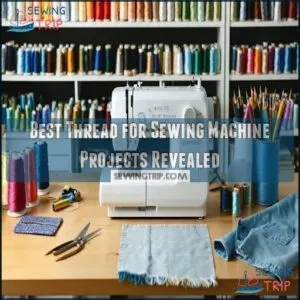This site is supported by our readers. We may earn a commission, at no cost to you, if you purchase through links.
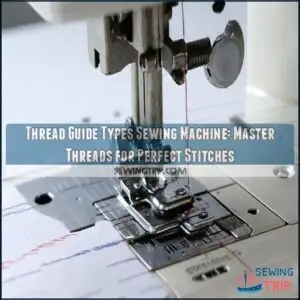 Thread guides on a sewing machine keep your thread in line for smooth stitching and prevent tangles.
Thread guides on a sewing machine keep your thread in line for smooth stitching and prevent tangles.
There are different types based on where they sit. Top thread guides, often near the spool pin, direct thread toward the tension disc.
Check-spring guides regulate tension during sewing, while the take-up lever lifts and lowers thread to lock stitches.
Lower guides, near the needle, guarantee proper alignment before the thread meets the fabric. Whether you’re using lightweight threads for delicate fabrics or heavier ones for upholstery, correctly threading these guides is key to avoiding headaches and guaranteeing clean, professional stitches every time, which is crucial for a smooth sewing experience with proper alignment.
Table Of Contents
Key Takeaways
- You’ll avoid tangles and get smooth stitches by properly threading top guides, check-spring guides, take-up levers, and lower guides.
- Each sewing machine model has specific thread guides, so check your manual for compatibility to prevent issues.
- Cleaning thread guides regularly with a soft brush keeps them dust-free and ensures smooth operation.
- Proper alignment of thread guides is crucial for balanced tension, faster sewing, and professional-looking stitches.
Thread Guide Basics
Understanding thread guides is key to smooth sewing and perfect stitches. They control thread tension, alignment, and flow, ensuring your machine operates efficiently.
Master thread guides for flawless stitches—they align, control tension, and ensure your sewing machine runs smoothly for every project.
Thread Types and Composition
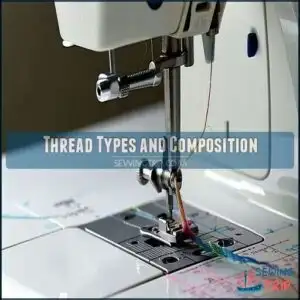
Threads are crafted from different fiber properties, blending materials like cotton, nylon, and polyester for varied uses.
Their composition impacts performance and durability.
Understanding thread types—the core materials and finishes—helps match threads to projects.
Remember these categories:
- Natural fibers: Cotton, silk, or linen.
- Synthetic fibers: Nylon, polyester, rayon.
- Core-spun: Strength-focused blends.
- Multi-ply threads: Increased durability.
Thread Weights and Uses
Understanding thread weights helps you achieve precise stitches. Weight, denier, and tex define thread thickness and uses across projects.
Use this guide:
| Thread Type | Weight | Best Uses |
|---|---|---|
| Light (50-60 wt) | Tex 18-24 | Delicates, fine embroidery |
| Medium (30-40 wt) | Tex 27-35 | Garments, home décor |
| Heavy (12-30 wt) | Tex 36+ | Durable seams, topstitching |
Choose bobbin threads for smoother sewing. High-quality threads help reduce unwanted lint production, as seen in the guide on unwanted lint production, which is crucial for achieving smooth sewing and durable seams.
Needle Pairing and Thread Performance
Proper needle pairing is key to stitching success. Choose the right needle size for thread weight to improve stitch consistency and reduce fabric damage.
Follow these steps:
- Use smaller needles for light threads.
- Pair heavier threads with larger needles.
- Invest in high thread quality for smooth performance.
- Check needle types for specific sewing machine thread compatibility to ensure smooth performance and prevent damage, which is crucial for stitching success.
Sewing Machine Thread
Choosing the right sewing machine thread guarantees smooth stitching and prevents common issues like breakage or skipped stitches.
You’ll need to match thread weight and material to your project for superior results.
Thread Weight Selection
Picking the right thread weight is key for smooth stitching. Thread weight numbers can confuse—higher numbers mean thinner thread.
For light fabrics, stick to a higher Denier vs Tex, like 50wt. Industrial threads, thicker than 18wt, fit heavy-duty tasks.
Bobbin thread, often lighter weight, guarantees balance. Remember, ply count indicates strength, essential for durability in sewing machine thread.
Thread Material and Fabric Compatibility
Choose sewing machine thread that pairs seamlessly with fabric types for smooth stitching. Pay attention to fiber properties, thread shrinkage, and material blends.
For best results:
- Use cotton threads for natural fabrics like linen or denim.
- Opt for polyester for stretch or synthetic materials.
- Consider thread performance factors for project longevity.
- Match needle compatibility to thread weight for project durability and perfect stitches.
Thread Tension and Stitch Quality
Thread tension holds the key to balanced stitches. Tight tension can cause fabric puckering, while loose tension leads to thread looping.
Adjust the sewing machine’s thread guide and bobbin tension carefully for smooth stitching.
Use this table for quick troubleshooting:
| Problem | Cause | Solution |
|---|---|---|
| Fabric Puckering | Tension too tight | Loosen upper thread tension |
| Thread Looping | Tension too loose | Tighten upper thread tension |
| Uneven Stitches | Bobbin tension off | Adjust bobbin tension screw |
The correct adjustment of thread tension is crucial to prevent issues like fabric puckering and ensure high-quality stitching.
Thread Weight Matters
Choosing the right thread weight guarantees your stitches hold up while looking neat and professional.
It’s all about matching the thread’s thickness to your fabric and project needs for the best results, which is a complete concept that ensures your stitches are durable and visually appealing.
Light Weight Threads for Delicate Fabrics
When working with delicate fabrics, lightweight threads (50-60 wt) are your go-to. They guarantee fine seam strength and flawless embroidery detailing while avoiding bulky stitching.
Use a fine needle (size 70/10 or 80/12) for smooth results. Adjust thread tension carefully for fabric type. Quality thread brands like Aurifil or Mettler make the job easier.
- Prevent thread tangles with fine needles.
- Lightweight threads suit lace and silk.
- Good tension keeps stitches smooth.
- Avoid lint with high-quality thread.
- Achieve intricate details effortlessly.
Medium Weight Threads for General Sewing
Medium weight threads are your go-to for general sewing projects.
They strike the right balance between strength and flexibility, ensuring smooth stitching.
Pair them with universal needles sized 80/12 or 90/14 for best results.
Whether you’re handling cotton or polyester, compatibility with most fabrics keeps your stitches neat.
Reliable thread brands boost durability and improve stitch appearance effortlessly.
Heavy Weight Threads for Decorative Stitches
When working with heavyweight threads like Tex 40-400, they’re perfect for decorative stitching or reinforcing thick fabrics.
Pair these threads with larger needles (size 14-27) to avoid breaks.
For decorative applications, adjust your sewing machine’s tension to maintain stitch quality.
Consider using a 90/14 topstitch needle for most 12wt threads to prevent shredding.
Explore brands like Gutermann for reliable options, and use a thread guide to guarantee compatibility with thread weights for seamless results.
Thread Selection Tips
Choosing the right thread guarantees your stitches are strong and your fabric stays intact. Match thread to your fabric type and project needs for the best results.
Matching Thread to Fabric Type
It’s essential to pair thread type with fabric type for project durability and a smooth sewing process.
Think about fiber compatibility, sheen, and purpose.
Use this quick thread guide to match:
- Cotton thread: Best for natural fabrics like cotton or linen.
- Polyester thread: Great for most projects, including stretch fabrics.
- Silk thread: Perfect for delicate fabrics.
- Rayon thread: Adds shine for decorative finishes.
- Heavy-duty threads: Ideal for upholstery or thick materials.
Considering Fabric Thickness and Stretch
Different fabrics demand thoughtful choices.
Light materials need finer threads, while thick fabrics call for heavier ones.
Stretchy fabrics? Opt for threads with good elasticity to prevent snaps.
Pair the right needle size with fabric thickness and thread elasticity for smooth sewing.
Use the table below as your quick thread guide replacement while threading your machine.
| Fabric Type | Fabric Weight | Stretch Percentage | Recommended Thread | Needle Size |
|---|---|---|---|---|
| Cotton | Light | Low (0-5%) | 50wt Cotton | 70/10 |
| Jersey Knit | Medium | Medium (10-20%) | Polyester 40wt | 80/12 |
| Denim | Heavy | Low (0-5%) | Topstitch 30wt | 100/16 |
| Spandex | Light | High (20-50%) | Elastic Thread | 75/11 |
| Wool Blend | Medium-Heavy | Low (0-5%) | Polyester 40wt | 90/14 |
The key to successful sewing is making the right fabric and thread choices, and understanding the importance of smooth sewing and the role of thread elasticity in achieving it.
Choosing High-Quality Thread for Durability
When selecting thread, durability is key for stitch longevity. Poor quality threads can snap or shed, disrupting your work.
Follow these tips:
- Choose higher thread strength and test for lint reduction to protect your machine.
- Opt for trusted brands with proven thread durability and lifespan.
- Look for colorfastness testing to guarantee vibrant, long-lasting results.
Master quality, master stitches!
Thread Storage and Care
Proper thread storage keeps your threads strong, smooth, and ready to use. Protect them from sunlight, humidity, and dust to avoid weakening or tangling over time.
Preventing Thread Deterioration and Fading
Thread fading and thread deterioration happen when sunlight exposure, humidity, or temperature effects take their toll.
Keep threads in a cool, dry spot, away from windows.
Use airtight storage solutions for humidity control.
Consider thread composition—natural fibers fade faster.
Many factors affect how threads age, including dust accumulation.
| Issue | Cause | Solution | Benefit |
|---|---|---|---|
| Fading | Sunlight exposure | Store threads away from light | Color lasts longer |
| Weakening | Humidity | Airtight containers | Stronger thread longevity |
| Brittleness | Temperature effects | Keep threads cool | Prevents breakage |
| Fast fading | Natural thread composition | Use UV-resistant storage bags | Maintains vibrant colors |
The table outlines the main thread issues, their causes, and solutions to prevent them, ultimately leading to longer thread life and better sewing results.
By following these guidelines, sewers can minimize the impact of environmental factors on their threads, ensuring they remain strong and vibrant for a longer period.
Organizing Threads for Easy Access
Keeping your threads organized boosts efficiency. Store them in thread storage boxes to keep them dust-free. Arrange spools and cones by weight/type for quick selection.
Use bobbin storage boxes to prevent unwinding. Consider browsing thread storage solutions for more options.
Stack everything in a cool, dry place to avoid damage. With the right thread organization, you’ll stress less and sew more smoothly.
- Use thread storage boxes.
- Organize by weight/type.
- Store spools and cones properly.
- Keep bobbin storage neat.
- Choose a cool, dry place.
Specialized Thread Types and Uses
Elastic shirring thread adds stretch for garments, while metallic threads offer shine for decorative stitches—just sew slowly to avoid breakage.
Waxed thread’s water resistance is perfect for upholstery projects, while variegated thread adds colorful flair.
Invisible thread blends seamlessly into fabrics, ideal for quilting or embroidery. Elastic thread is available for various sewing needs.
Each specialized thread enhances creativity but requires the right settings and technique for smooth use.
Frequently Asked Questions (FAQs)
What guides the thread on a sewing machine?
Think of a sewing machine as the ultimate multitasker.
It guides thread with built-in mechanisms like tension discs, thread guides, and take-up levers, ensuring smooth flow and precise stitches while keeping tangles at bay, with complete concepts of thread management being crucial.
Which is thicker, 40 wt or 50 wt thread?
A 40 wt thread is thicker than a 50 wt thread.
Thread weight works inversely—lower numbers mean thicker threads, while higher numbers signify thinner ones.
So, choose 40 wt for stronger, more visible stitches.
What are the different types of thread used in sewing?
Sewing threads include cotton for natural fabrics, polyester for durability, rayon for shine, silk for strength, and nylon for elasticity.
Specialty threads like metallic, elastic, or variegated for decorative stitching and specific uses.
What is the difference between 30 wt and 40 wt thread?
30 wt thread is thicker than 40 wt, making it better for bold, decorative stitching or heavy fabrics.
Use 40 wt for standard sewing and embroidery projects—it’s thinner, more versatile, and ideal for detailed work.
How to troubleshoot thread guide alignment issues?
Aligning thread guides is like following a roadmap—one misstep detours the thread path.
Check for bent guides, tighten screws, and make certain smooth threading.
Test with lower tension to avoid unnecessary strain or misalignment.
What are thread guide maintenance best practices?
Keep your thread guides dust-free by gently brushing them regularly.
Check for wear or damage that could cause snags.
Avoid using lubricants unless specified by the manufacturer, and store your machine in a clean, dry place.
Can thread guides affect sewing speed?
Thread guides are like traffic signs for your thread.
When aligned properly, they prevent tension issues, tangles, and breakage, allowing smoother movement.
Misaligned guides, however, can impede speed, causing interruptions and uneven stitches, which can lead to tangles.
How to clean built-in thread guides effectively?
To clean built-in thread guides, use a soft brush, like a lint brush or a small paintbrush, to remove dust and lint.
Avoid harsh tools or liquids, as they might damage the sewing machine.
Are thread guides universal or machine-specific?
Thread guides aren’t universal; they’re designed to match the specific features of your sewing machine model.
Always check the manual to confirm compatibility or you might face threading issues or uneven stitches.
Conclusion
Mastering the different thread guide types on a sewing machine transforms tangled messes into smooth, professional stitches.
Properly using top guides, check-spring guides, take-up levers, and lower guides guarantees clean alignment and balanced tension.
Lightweight, medium, or strong threads all rely on precise threading for perfect results.
Whether tackling delicate fabrics or upholstery, staying mindful of thread compatibility and guide usage guarantees success.
Keep practicing and refining, and you’ll achieve flawless seams every time.

